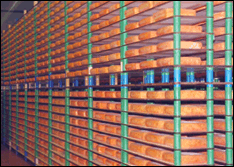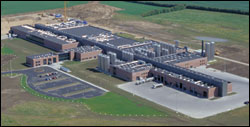

MD successor Arla Foods in September 2000 celebrated the realization of that vision. The 35,000-sq.-meter plant immediately won respect in Danish dairy circles -- no small feat in a country known for its cheese -- and just as quickly impressed dairy professionals from around the world who came to see it.
Operations director Lars Dalsgaard invested three years of intensive work as team leader. The result is a plant that has a capacity of 55 million lbs. of what the Danes call "yellow cheese" and has built-in capacity for double that amount. But it also is highly flexible, environmentally friendly and aesthetically pleasing.
At the project's inception in April 1997, the key criteria were quality, efficiency and environmental compatibility, revolving around a core of flexibility, recalls Dalsgaard.
"Quality had to emanate from the dairy itself," he says. "That is why the buildings are made of brick instead of the usual drab, gray concrete panels. The large, shiny stainless-steel silo tanks are an aesthetic treat.
"We began by setting up an overall project organization with a so-called sponsor group of three, including the managing directors of the two dairy companies involved at that time, MD Foods and KlNver M¿," he explains. Those firms subsequently merged, prior to being folded into Arla in April 2000.
The project was probably the largest single investment in the history of the Danish dairy industry. A four-person management group handled the technical aspects of the project.
Decentralized planning
The project was further divided into 11 parts, each led by its own project manager. Those 11 groups typically consisted of two to four members, often employees from other dairies who were familiar with the kind of cheeses to be manufactured. "In the planning phase these groups systematically specified how this kind of dairy should be constructed," Dalsgaard says. "Every critical factor was considered as the product moves from one processing stage to the next. Along the way we have benchmarked against processes known from other dairies."
The results of this analysis were given to key vendors. They included:
- Buildings: MA Project A/S, a Danish architecture & engineering firm
- Processing and automation: APV Nordic
- Machinery & equipment: Tetra Pak, Lund, Sweden
- Energy: RambNll, a Danish engineering firm specializing in energy management
- Buildings: HNjgaard & Schultz , a world-class Danish construction firm.
Once installation had been completed, heads of the project teams -- in close cooperation with the suppliers -- were in charge of the commissioning phase. Many members of the project groups are now part of today's operating management.
"That was, and still is, a huge advantage," Dalsgaard emphasizes.
Project completion was accomplished on schedule, and the Taulov Dairy now has an intake of 1.1 billion lbs. of milk annually. Half goes into cheese making at the dairy, with the balance distributed to other Arla Foods dairies.
Computer-assisted siting
Finding the best location to the 1,200 dairy farmers who would provide the plant's raw materials was no small task. The expected location of future suppliers was also considered, owing to the major structural rationalization taking place in the Danish livestock industry.
An advanced computer program was used to calculate the optimum location. On this basis, a 75-acre plot at Fredericia with an option for another 50 acres was chosen, close to a major highway intersection. Consideration also was given to the possibility of manufacturing other dairy products at this site.
The plant's cheese output generates huge quantities of whey, and Arla Foods has a growing reputation as a supplier of this food ingredient. Whey's milk proteins and lactose are considered important products.
Danish dairies long have produced large volumes of cheese for export, and Danish processors and exporters have had to meet very different requirements for the taste and composition of the cheeses. "All our productions are niche products, even our Danbo cheese, which is sold almost exclusively in the home market and in Germany," explains Dalsgaard.
"Maintaining this flexibility has been imperative to us in order to meet future customer requirements. Even now we produce 30 different variants of yellow cheeses. In very little time we can meet new customer requirements and proposals."
The vendor interface
The marching orders for suppliers to the project were to create "an efficient, flexible dairy plant producing cheeses of a very high quality without internal or external environmental problems and with an optimal production economy," recalls Carsten Balling Lund, marketing manager of APV Nordic. "These objectives were kept in focus by the APV and Arla Foods project teams throughout the project, and the results are demonstrated in multiple ways in the design and functionality of the cheese plant."
APV's responsibilities included the design and fabrication of process and cheesemaking equipment, its installation and commissioning and staff training. Specific elements were:
- Process and software design, mechanical and electrical engineering
- A process control solution using Foxboro I/A with a fully integrated batch control system
- Milk reception comprising eight unloading stations with a capacity of 960,000 lbs. per hour
- Milk treatment plant
- Cheese plant consisting of six APV CurdMaster cheese vats, 2 OPD prepresses and a SaniPress for final pressing of the cheeses
- Cheese cooling and brining plant
- Brine preparation plant
- Whey treatment plant with ultra-filtration and reverse osmosis for production of whey protein concentrate (WPC)
- Eight clean-in-place (CIP) plants
Equipment installation began in March 1999, and nine months later the first cheeses were produced -- right on schedule.
"APV's use of HACCP during the mechanical design phase contributed to the successful completion of the project," says Bent Ipsen, APV's lead project manager. "With this tool we were able to identify critical areas where design changes were required or desired.
"The teamwork and commitment signified by the strict adherence to defined milestones was another important aspect for the successful project management," Ipsen says. "The agreed functionality analysis and performance criteria were used as a tool for the design, installation and commissioning engineers to maintain focus along the way. Last but not least, the meetings of the joint Arla and APV steering committee provided for a common understanding of the project and its complexity."
To create an intelligent dairy, APV deployed the open-architecture Foxboro I/A series Windows NT platform, which supports paperless production and provides full traceability of production, processes and products, from milk intake to dispatch of products. Programmed according to the S-88 batch standard, the system controls 1,200 valves with intelligent controls through a Profibus network. A common, user-friendly operator interface is used in the process area and control rooms, and the automation system is prepared for executing orders directly from the dairy plant's SAP enterprise resource planning system.
Among Taulov's innovations is the "Fox History" database, a tool for tracking and graphically visualizing data collected from any single point throughout the plant. This tool can be used for technical and technological trouble-shooting. The SaniPress final pressing system is made in a completely closed design including form-filling and emptying equipment. The CIP cheesemaking equipment ensures that the production room's floor is kept dry. The microfiltration plant for the brine ensures that the brine is kept bacteria-free without any heat treatment.
The external environment was a focus throughout the project. The whey treatment plant uses ultrafiltration and reverse osmosis to ensure full utilization of the whey. The whey is processed into raw material for WPC production, fodder and reusable water. The water is used for CIP and general cleaning purposes. The energy recovery system recirculates heat from the warm whey to heat the cheese milk before it is filled into the vats. The cold side of the milk is used to cool down the whey.
The Danish Energy Agency, an office of the Ministry of Environment and Energy, invited the dairy to be part of a comprehensive pilot project. All processes and supplies were scrutinized from an energy point of view. This scrutiny, which is publicly available, was conducted by MA Project A/S, which is renowned for its expertise in this field.
Art meets science
Can the craft of cheesemaking survive in a modern, high-tech processing company?
"Absolutely," Dalsgaard says, without hesitation. "To me, craft does not necessarily mean manual handling of the cheeses. Rather, craft means ensuring the use of the right cultures at optimum capacity, that the additives used are right and of superior quality and that the recipes from other dairies are carried on under the new conditions.
"Although moving cheese production is never problem-free, we have managed well so far, particularly owing to the excellent Danish tradition of practical and theoretical dairy education. It is a culture that we need to protect and expand."
A visitors' gallery has been constructed overlooking the production process as a tangible symbol of the openness practiced by Arla Foods. "We are proud of our new dairy and can't wait to show it off to visitors, dairy professionals, consumers and students," Dalsgaard says. "And we promise not to let visitors go until they have sampled our cheeses."